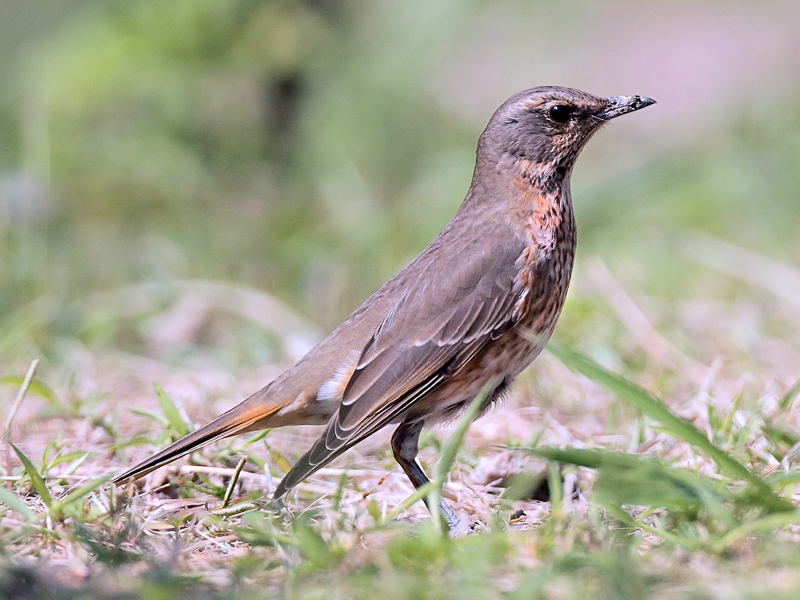Naumann’s Thrush Turdus naumanni 紅尾鶇
Category I. Accidental winter visitor.
IDENTIFICATION

Dec. 2012, Martin Hale. Adult male.
23-25 cm. Medium size thrush with rather stout bill. Adult male has greyish upperparts with the rump and tail brighter rufous. The supercilium is pale orange and curls behind the dull brown cheeks to meet orange-rufous neck sides and upper chest. The throat and chest are streaked darker rufous, while the lower chest to vent are whitish with dark rufous feather centres. The undertail coverts are more extensively dark rufous. The wings are greyish-brown with pale whitish to pale orange fringes to both coverts and remiges. The adult female is similar but duller and less rufous. The chin and throat are more heavily spotted or streaked with a more distinct malar stripe, while the scapulars and wing coverts show less rufous.

Nov. 2010, Michelle and Peter Wong. First-winter.
First-winter birds are duller and darker than adult females, often with little or no rufous on the upperparts. The rufous centres to the underpart feathers are less visible and there is more dark streaking at the side of the throat and malar. In fresh plumage the tips to the wing coverts and tertials are obviously whitish (Clement and Hathway 2000).
Compared to Dusky Thrush paler with plainer wings and head; underparts usually have orange scaling. The upright stance and calls are similar. First-winter differs from same-age Red-throated Thrush in having rufous flanks, rufous and grey underbody blotching and rufous on undertail coverts (Shirihai and Svensson 2018).
VOCALISATIONS
The common flight call is ‘chee’ uttered one or more times, similar to that of Red-throated Thrush but fuller. Also more typical thrush like calls that are perhaps slightly higher in pitch than usual.
DISTRIBUTION & HABITAT PREFERENCE
All records have occurred in areas of open country, away from closed-canopy forest or shrubland.
OCCURRENCE
A rare winter visitor, with records from 12 November to 19 April. There were nine records during 1974-1982 (Chalmers 1986), all of singles apart from one record of two birds from 5 January to 19 April. Most of these lack substantiation of the sort that is currently required. Since then there have been only four records, as follows:
1990: one at Tung Chung on 29 January and one at Mai Po NR on 14 November.
2010: a first-winter at Lok Ma Chau on 12 November.
2012: an adult male at Chek Lap Kok during 27-29 December.
2016: a first-winter at Mount Davis on 25 March.
RANGE & SYSTEMATICS
Monotypic. Breeds southeast and south central Siberia, although birds breed north or south of this core area in some years; winters to the south in southern Ussuriland, the Korean peninsula and in northeast and east China (Clement and Hathway 2000). Although Liu and Chen (2021) indicate it occurs in winter across the whole of south China, records south of the Chang Jiang (Yangtze River) are probably irregular based on its status in HK.
CONSERVATION STATUS
IUCN: Least Concern. Population trend unknown.
Clement, P. and R. Hathway (2000). Thrushes. Christopher Helm, London.
Liu, Y. and S. H. Chen (eds) (2021). The CNG Field Guide to the Birds of China (in Chinese). Hunan Science and Technology Publication House.
Shirihai, H. and L. Svensson (2018). Handbook of Western Palearctic Birds Vol. 1. Passerines: Larks to Warblers. Helm, London.

